Numerical Study on the Influence of Interceptor and Stern Flap on Ship Resistance and Motion Response in Regular Waves
Abstract
1. Introduction
2. Numerical Method and Approach
2.1. Governing Equations and Turbulence Model
2.2. Free Surface Modeling
2.3. Geometry Model and Simulation Conditions
2.4. Numerical Wave Generation and Data Processing
2.5. Computational Domain and Mesh Generation
3. Verification and Validation
3.1. Verification of the Mesh and Time Step
3.2. Validation of Resistance and Motion in Calm Water
4. Results and Discussions
4.1. Influence of Stern Appendages on Ship Resistance
4.2. Influence of Stern Appendages on Ship Motion
4.3. Influence of Stern Appendages on the Ship Flow Field
5. Conclusions and Future Works
- (1)
- For the BH at wave steepness ak = 0.075, the added resistance coefficient increases and then diminishes as the wavelength increases. At λ/LPP = 1.5, the green water phenomenon occurs on the BH deck, leading to an added resistance peak of 70.6%.
- (2)
- Within the λ/LPP = 0.5–2.5 range, the resistance reduction rates for both appendages in wave conditions decline and then increase with the wavelength. Generally, these resistance reduction rates outperform calm water conditions by 1–3%. Notably, at λ/LPP = 2.5, the stern flap resistance reduction rate surpassed the calm water rate by 6.6%.
- (3)
- At a consistent wavelength of 1.5 LPP and wave steepness ak > 0.05, the resistance reduction rates for both appendages in regular waves declined as the wave steepness increased.
- (4)
- Installing the appendages diminishes the pitch across all wave steepness ranges and decreases the heave at ak = 0.025–0.075. Given the enhanced ship motion amplitude in wave conditions, the influence of the stern appendages on the posture of the ship was notably enhanced.
- (5)
- A remarkable reduction in TF3 and TF5 was observed post-installation of the appendages, particularly within the λ/LPP = 1–2 range. The SF outperformed the interceptor in ship seakeeping, achieving reductions in TF3 and TF5 of 7.2% and 3.9%, respectively, versus 4.4% and 2.1%.
- (6)
- The inclusion of stern appendages decreases the height of the stern wave system, most notably in the rooster tail area. The SF offers a more pronounced optimisation of the stern flow field and reduces resistance slightly more effectively than the interceptor.
Author Contributions
Funding
Institutional Review Board Statement
Informed Consent Statement
Data Availability Statement
Conflicts of Interest
References
- Choi, H.; Park, J.; Kim, D.; Kim, S.; Lee, J.; Ahn, J.; Kim, N. System identification and pitch control of a planing hull ship with a controllable stern intercepter. J. Soc. Nav. Archit. Korea 2018, 5, 401–414. [Google Scholar] [CrossRef][Green Version]
- Villa, D.; Brizzolara, S. A systematic analysis of flap/interceptors hydrodynamic performance. In Proceedings of the International Conference on Fast Sea Transport, Athens, Greece, 5–8 October 2009. [Google Scholar]
- Katayama, T.; Suzuki, K.; Ikeda, Y. A new ship motion control system for high-speed craft. In Proceedings of the 7th International Conference on Fast Sea Transportation, Ischia, Italy, 7–10 October 2003. [Google Scholar]
- Brizzolara, S. Hydrodynamics analysis of interceptors with CFD methods. In Proceedings of the 7th International Conference on Fast Sea Transportation, Ischia, Italy, 7–10 October 2003. [Google Scholar]
- Brizzolara, S.; Salian, R. Adjustable energy saving device for transom stern hulls. In Proceedings of the SNAME Maritime Convention, Providence, RI, USA, 25 October 2018. [Google Scholar]
- Deng, R.; Huang, D.B.; Zhou, G.L. Preliminary numerical research of the hydrodynamic mechanism of interceptor. J. Ship Mech. 2012, 16, 740–749. [Google Scholar]
- Mansoori, M.; Fernandes, A.C. Hydrodynamics of the interceptor on a 2D flat plate by CFD and experiments. J. Hydrodyn. 2015, 27, 919–933. [Google Scholar] [CrossRef]
- Jacobi, G.; Thill, C.H.; van’t Veer, R.; Juijasmans, R.H.M. Analysis of the influence of an interceptor on the transom flow of a fast ship by pressure reconstruction from stereoscopic scanning PIV. Ocean Eng. 2019, 181, 281–292. [Google Scholar] [CrossRef]
- Tsai, F.J.; Hwang, J.L. Study on the compound effects of interceptor with stern flap for two fast monohulls. In Proceedings of the Oceans ‘04 MTS/IEEE Techno-Ocean ‘04 (IEEE Cat. No.04CH37600), Kobe, Japan, 9–12 November 2004; Volume 2, pp. 1023–1028. [Google Scholar]
- John, S. Hydrodynamic Performance Enhancement Using Stern Wedges, Stern Flaps, and Interceptors for Ships; ISCOT: Kharagpur, India, 2011. [Google Scholar]
- De Luca, F.; Pensa, C. Experimental investigation on conventional and unconventional interceptors. Trans. R. Inst. Nav. Architects. Part B Int. J. Small Craft Technol. 2012, 154, 65–72. [Google Scholar]
- Mansoori, M.; Fernandes, A.C. The interceptor hydrodynamic analysis for controlling the porpoising instability in high speed crafts. Appl. Ocean Res. 2016, 57, 40–51. [Google Scholar] [CrossRef]
- Mansoori, M.; Fernandes, A.C. Interceptor and trim tab combination to prevent interceptor’s unfit effects. Ocean Eng. 2017, 134, 140–156. [Google Scholar] [CrossRef]
- Mansoori, M.; Fernandes, A.C. Hydrodynamics of the interceptor analysis via both ultra-reduced model test and dynamic CFD simulation. J. Offshore Mech. Arct. Eng. 2017, 139, 021101. [Google Scholar] [CrossRef]
- Maki, A.; Arai, J.; Tsutsumoto, T.; Suzuki, K.; Miyauchi, Y. Fundamental research on resistance reduction of surface combatants due to stern flaps. J. Mar. Sci. Technol. 2016, 21, 344–358. [Google Scholar] [CrossRef]
- Avci, A.G.; Barlas, B. An experimental investigation of interceptors for a high speed hull. Int. J. Nav. Archit. Ocean. Eng. 2019, 11, 256–273. [Google Scholar] [CrossRef]
- Deng, R.; Chen, S.Y.; Wu, T.C.; Luo, F.Q.; Jiang, D.P.; Li, Y.L. Investigation on the influence induced by interceptor on the viscous flow field of deep-sea vessel. Ocean Eng. 2020, 196, 106735. [Google Scholar] [CrossRef]
- Budiarto, U.; Samuel, S.; Wijaya, A.A.; Yulianti, S.; Kiryanto, K.; Iqbal, M. Stern flap application on planing hulls to improve resistance. Int. J. Eng. 2022, 35, 2313–2320. [Google Scholar] [CrossRef]
- Belibassakis, K.; Filippas, E.; Papadakis, G. Numerical and experimental investigation of the performance of dynamic wing for augmenting ship propulsion in head and quartering seas. J. Mar. Sci. Eng. 2021, 10, 24. [Google Scholar] [CrossRef]
- Capasso, S.; Tagliafierro, B.; Mancini, S.; Martínez-Estévez, I.; Altomare, C.; Domínguez, J.M.; Viccione, G. Regular wave seakeeping analysis of a planing hull by smoothed particle hydrodynamics: A Comprehensive Validation. J. Mar. Sci. Eng. 2023, 11, 700. [Google Scholar] [CrossRef]
- Sun, X.S.; Yao, C.B.; Xiong, Y.; Ye, Q. Numerical and experimental study on seakeeping performance of a SWATH vehicle in head waves. Appl. Ocean Res. 2017, 68, 262–275. [Google Scholar] [CrossRef]
- Niklas, K.; Pruszko, H. Full scale CFD seakeeping simulations for case study ship redesigned from V-shaped bulbous bow to X-bow hull form. Appl. Ocean Res. 2019, 89, 188–201. [Google Scholar] [CrossRef]
- Gong, J.; Yan, S.; Ma, Q.; Li, Y. Added resistance and seakeeping performance of trimarans in oblique waves. Ocean Eng. 2020, 216, 107721. [Google Scholar] [CrossRef]
- Guan, G.; Wang, L.; Geng, J.; Zhuang, Z.; Yang, Q. Parametric automatic optimal design of USV hull form with respect to wave resistance and seakeeping. Ocean Eng. 2021, 235, 109462. [Google Scholar]
- Day, A.H.; Cooper, C. An experimental study of interceptors for drag reduction on high-performance sailing yachts. Ocean Eng. 2011, 38, 983–994. [Google Scholar] [CrossRef]
- Rijkens, A.; Cleijsen, H.; Keuning, J. On the hydrodynamic performance of an improved motion control device for fast ships. In FAST 2013; FAST Organizing Committee: Amsterdam, The Netherlands, 2013. [Google Scholar]
- Karimi, M.H.; Seif, M.S.; Abbaspoor, M. A study on vertical motions of high-speed planing boats with automatically controlled stern interceptors in calm water and head waves. Ships Offshore Struct. 2015, 10, 335–348. [Google Scholar]
- Park, J.Y.; Choi, H.; Lee, J.; Choi, H.; Woo, J.; Kim, S.; Kim, D.J.; Kim, S.Y.; Kim, N. An experimental study on vertical motion control of a high-speed planing vessel using a controllable interceptor in waves. Ocean Eng. 2019, 173, 841–850. [Google Scholar] [CrossRef]
- Wang, X.; Liu, L.; Zhang, Z.; Feng, D. Numerical study of the stern flap effect on catamaran’s seakeeping characteristic in regular head waves. Ocean Eng. 2020, 206, 107172. [Google Scholar] [CrossRef]
- Li, Y.; Li, A.; Gong, J.; Fu, Z.; Dai, K. Numerical investigation on added resistance and motions of a high-speed trimaran equipped with T-foil and stern flap in regular head and oblique waves for varying wave steepness. J. Braz. Soc. Mech. Sci. Eng. 2021, 43, 451. [Google Scholar] [CrossRef]
- Song, K.W.; Guo, C.Y.; Gong, J.; Li, P.; Wang, L.Z. Influence of interceptors, stern flaps, and their combinations on the hydrodynamic performance of a deep-vee ship. Ocean Eng. 2018, 170, 306–320. [Google Scholar] [CrossRef]
- Wang, W.; Wu, T.; Zhao, D.; Guo, C.; Luo, W.; Pang, Y. Experimental-numerical analysis of added resistance to container ships under presence of wind-wave loads. PLoS ONE 2019, 14, e0221453. [Google Scholar]
- ITTC. Practical Guidelines for Ship CFD Applications. In Proceedings of the 26th ITTC, Rio de Janeiro, Brazil, 28 August–2 September 2011. [Google Scholar]
- Xing, T.; Stern, F. Factors of safety for Richardson extrapolation. J. Fluids Eng. 2010, 132, 061403. [Google Scholar] [CrossRef]
- Huang, S.; Jiao, J.; Chen, C. CFD prediction of ship seakeeping behavior in bi-directional cross wave compared with in uni-directional regular wave. Appl. Ocean Res. 2021, 107, 102426. [Google Scholar] [CrossRef]
- Tezdogan, T.; Demirel, Y.K.; Kellett, P.; Khorasanchi, M.; Incecik, A.; Turan, O. Full-scale unsteady RANS CFD simulations of ship behaviour and performance in head seas due to slow steaming. Ocean Eng. 2015, 97, 186–206. [Google Scholar] [CrossRef]

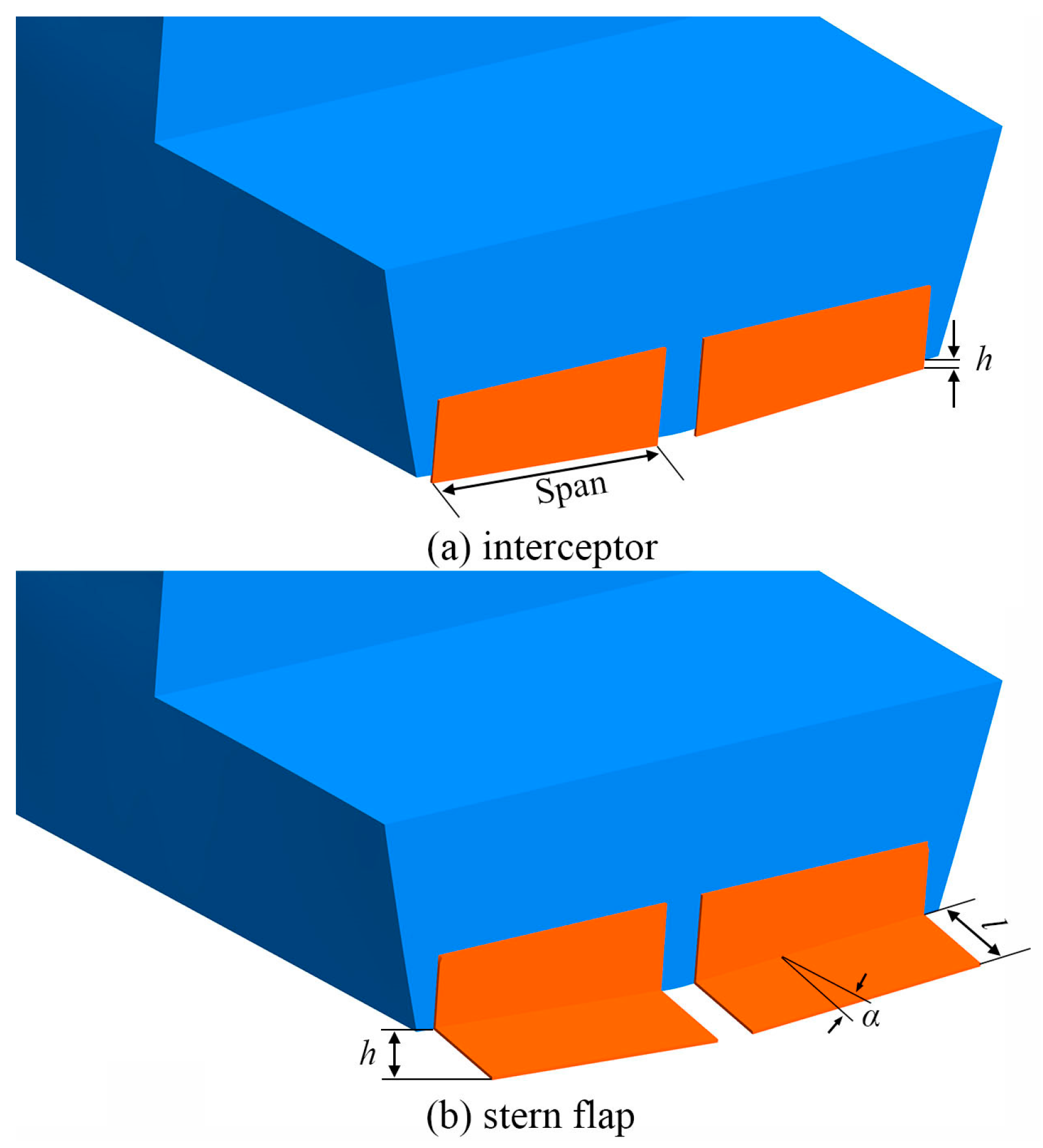
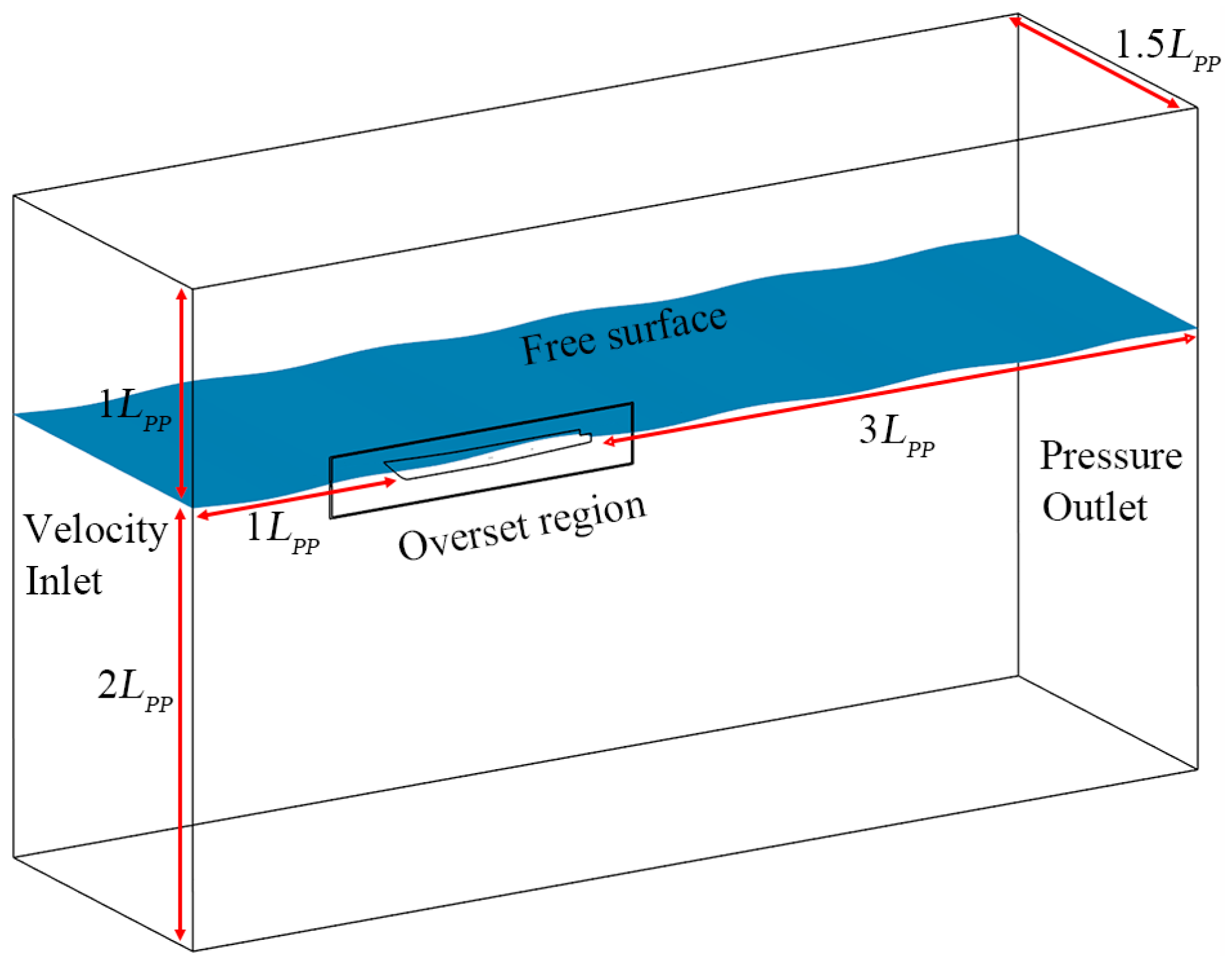
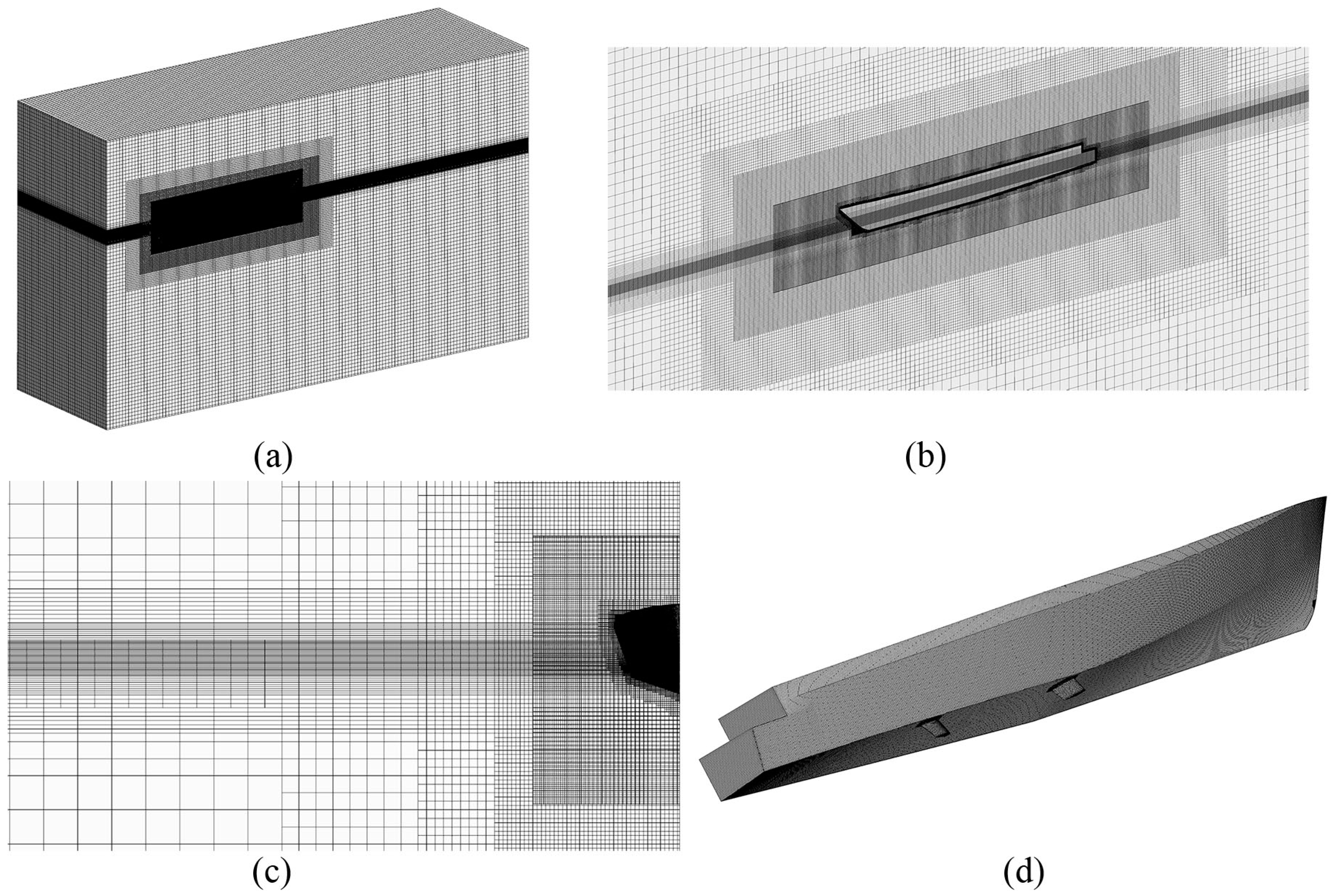
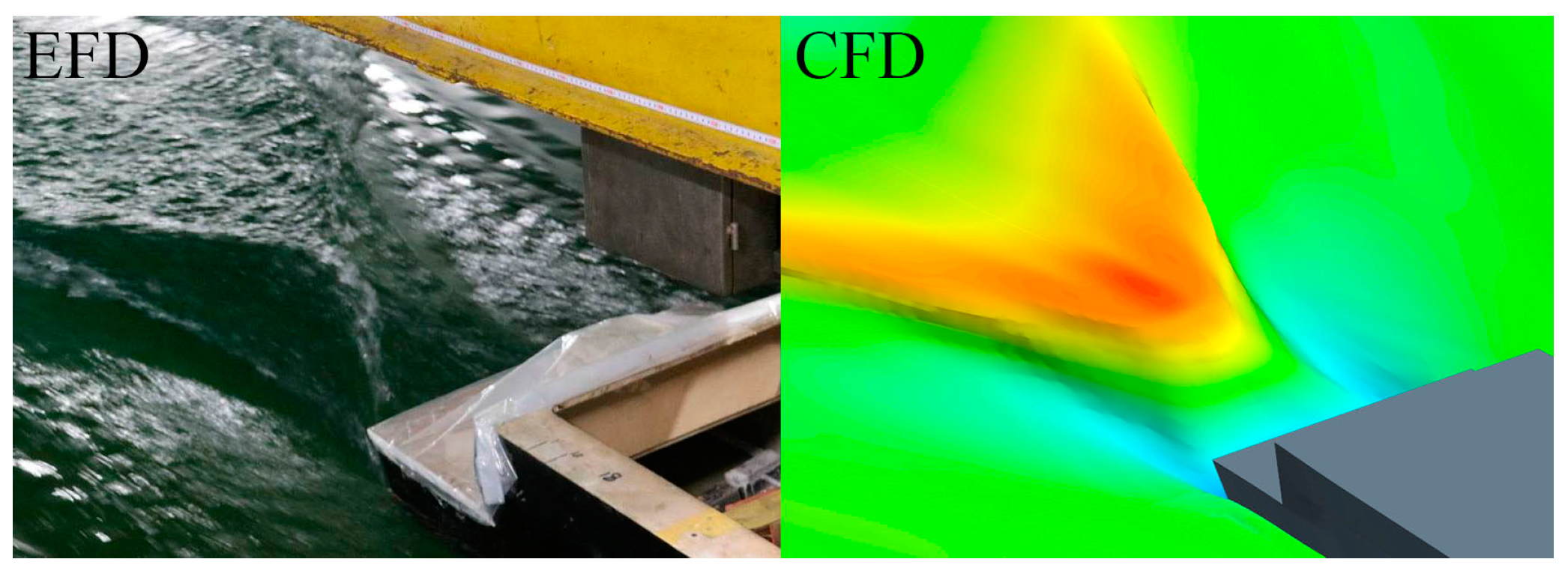
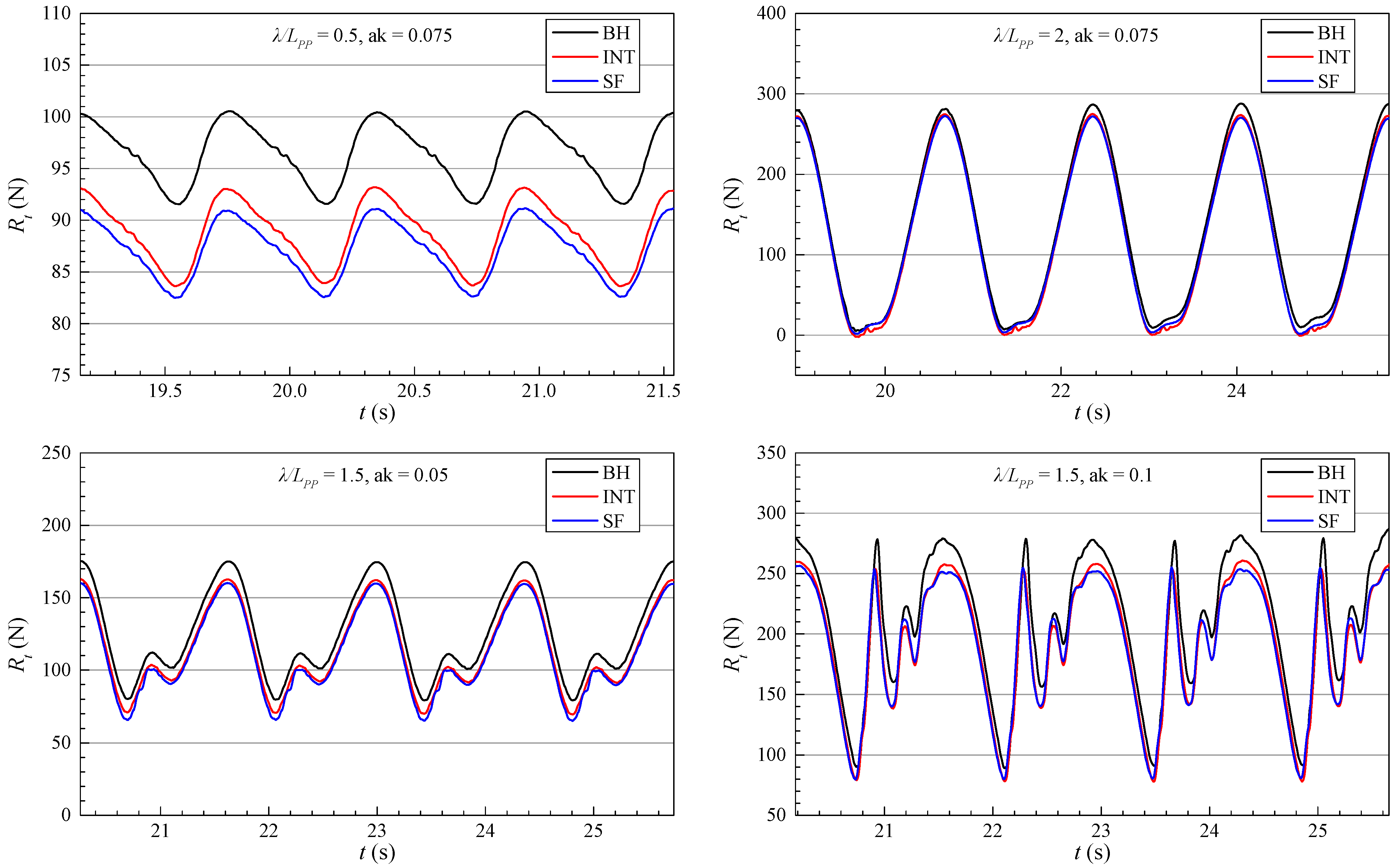
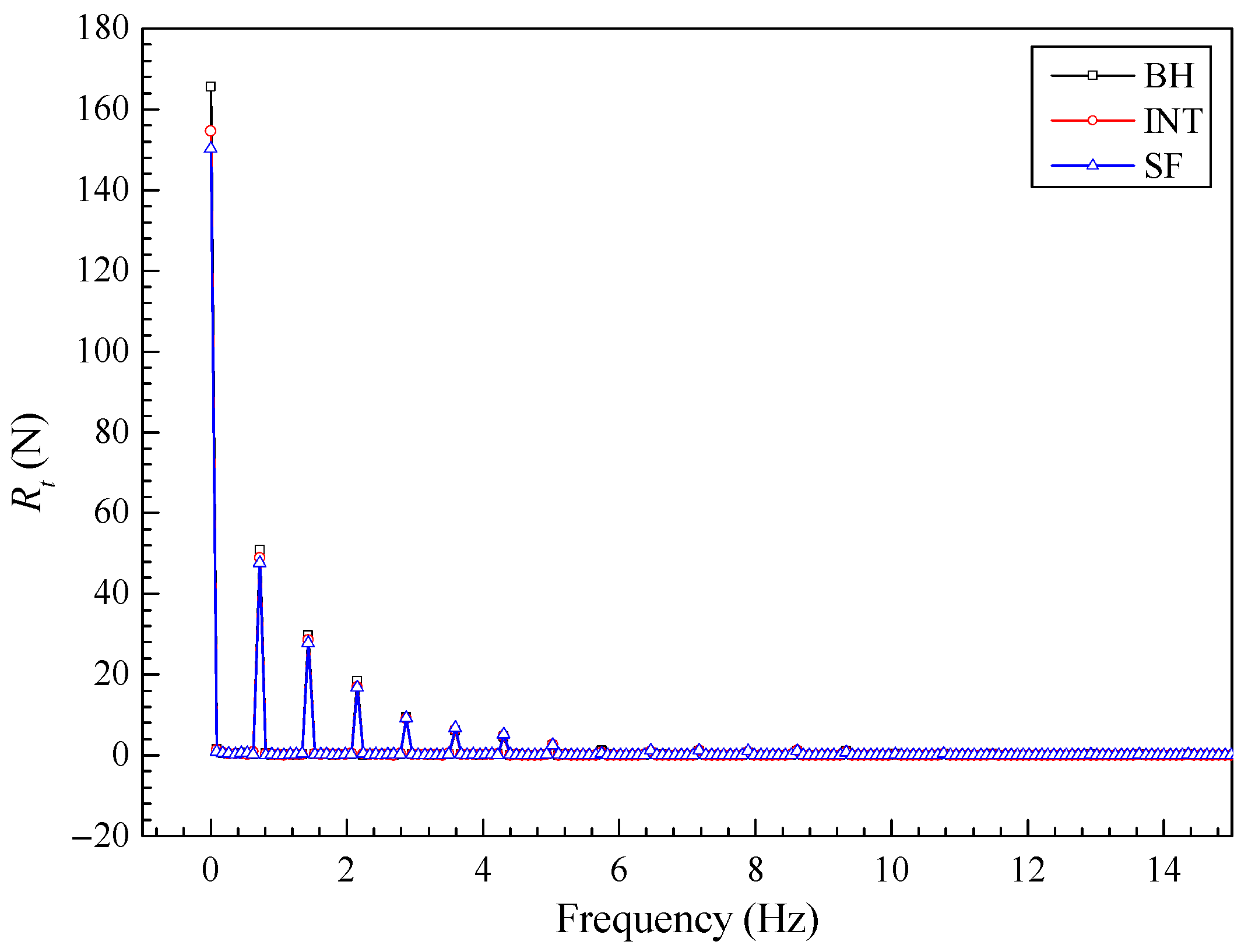
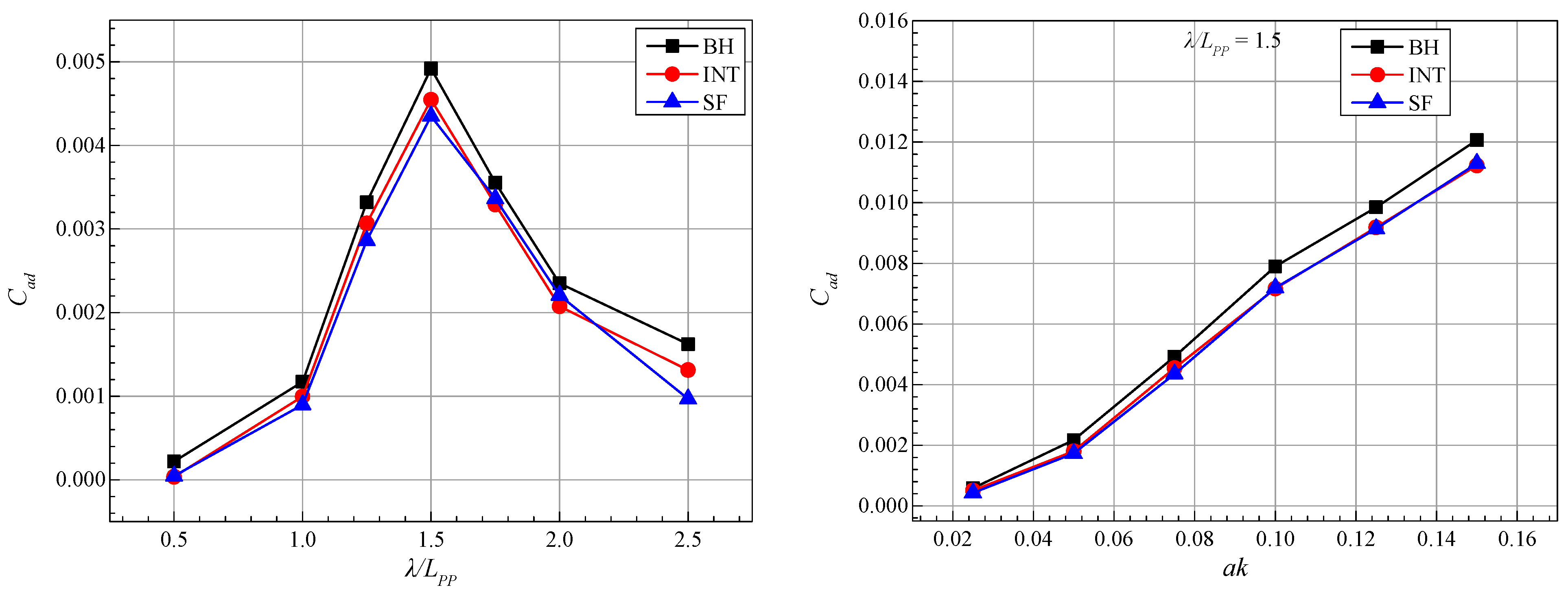
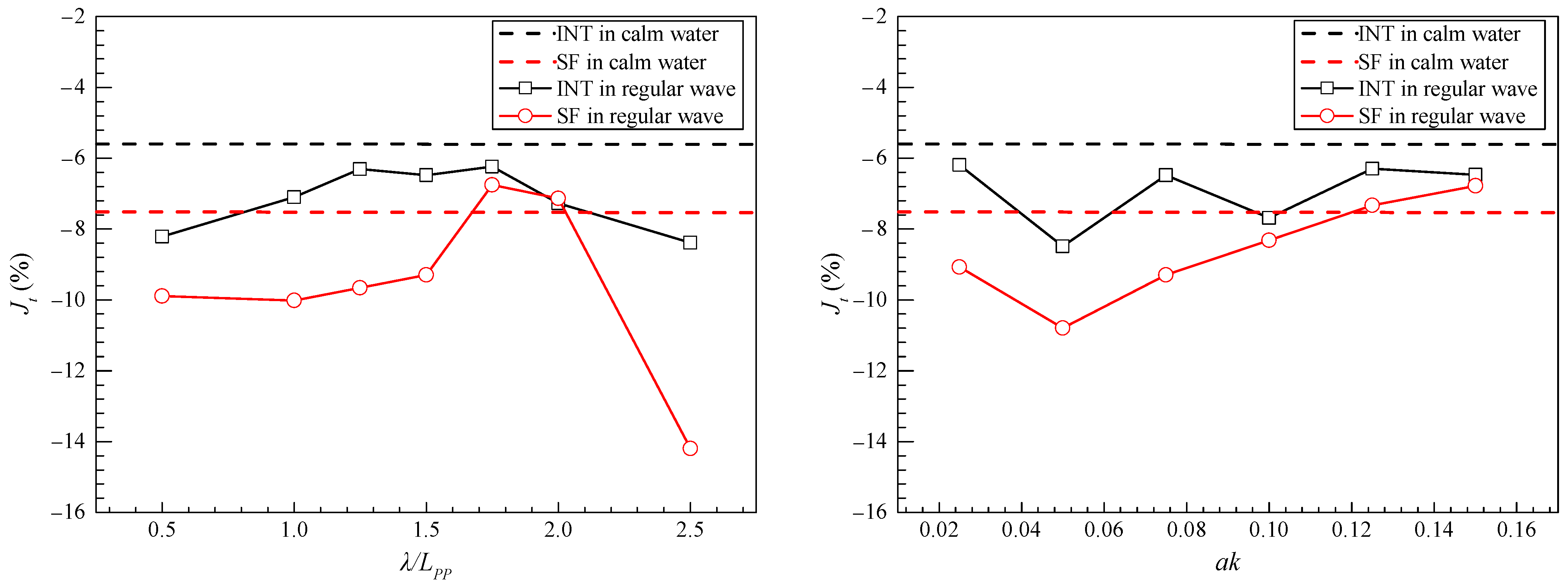




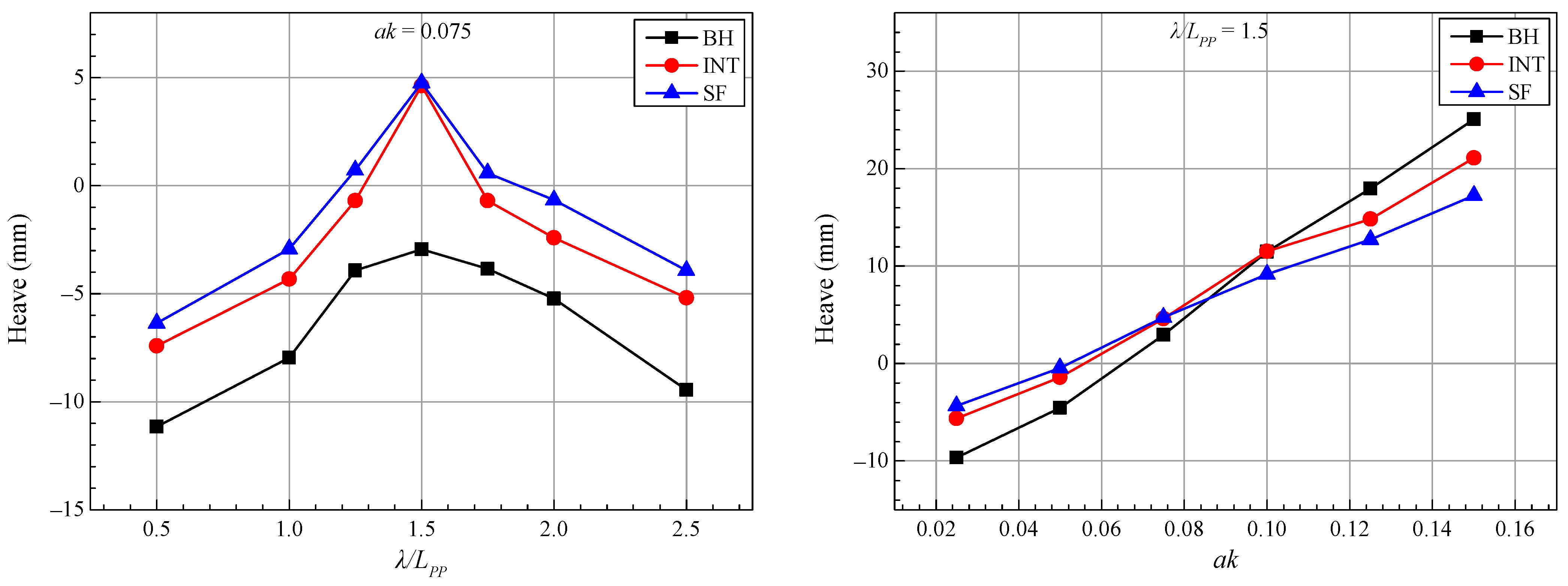

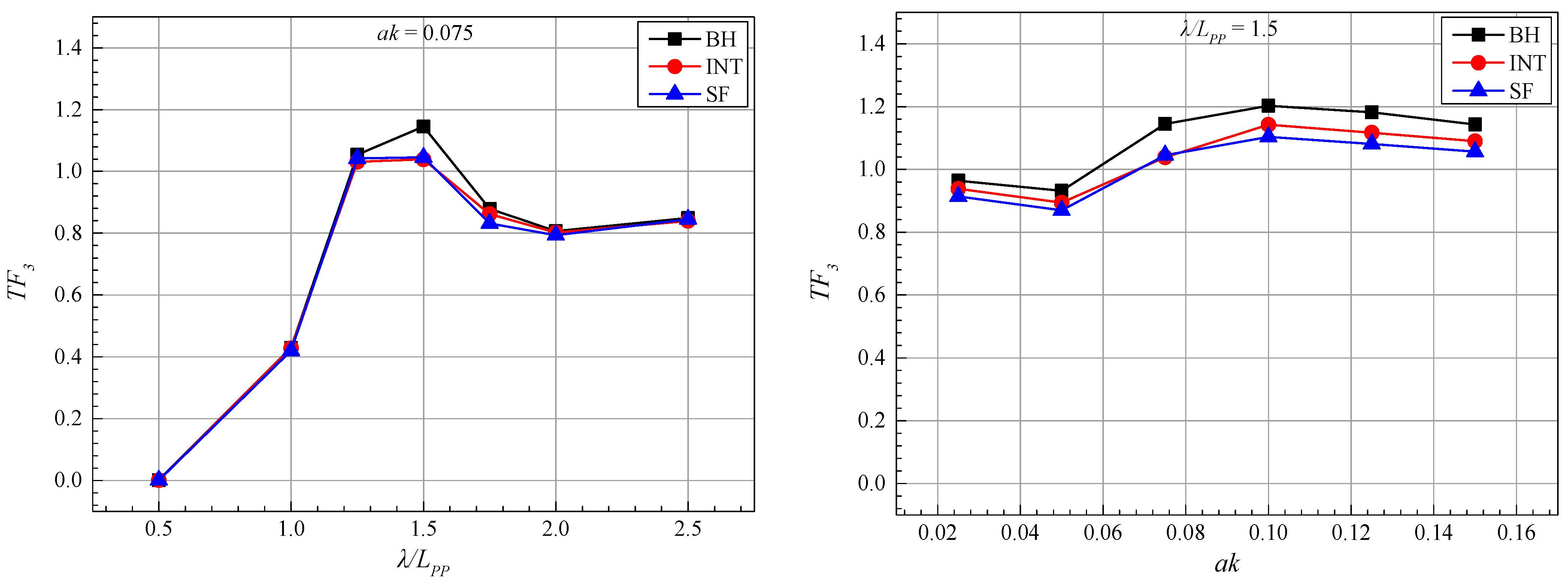

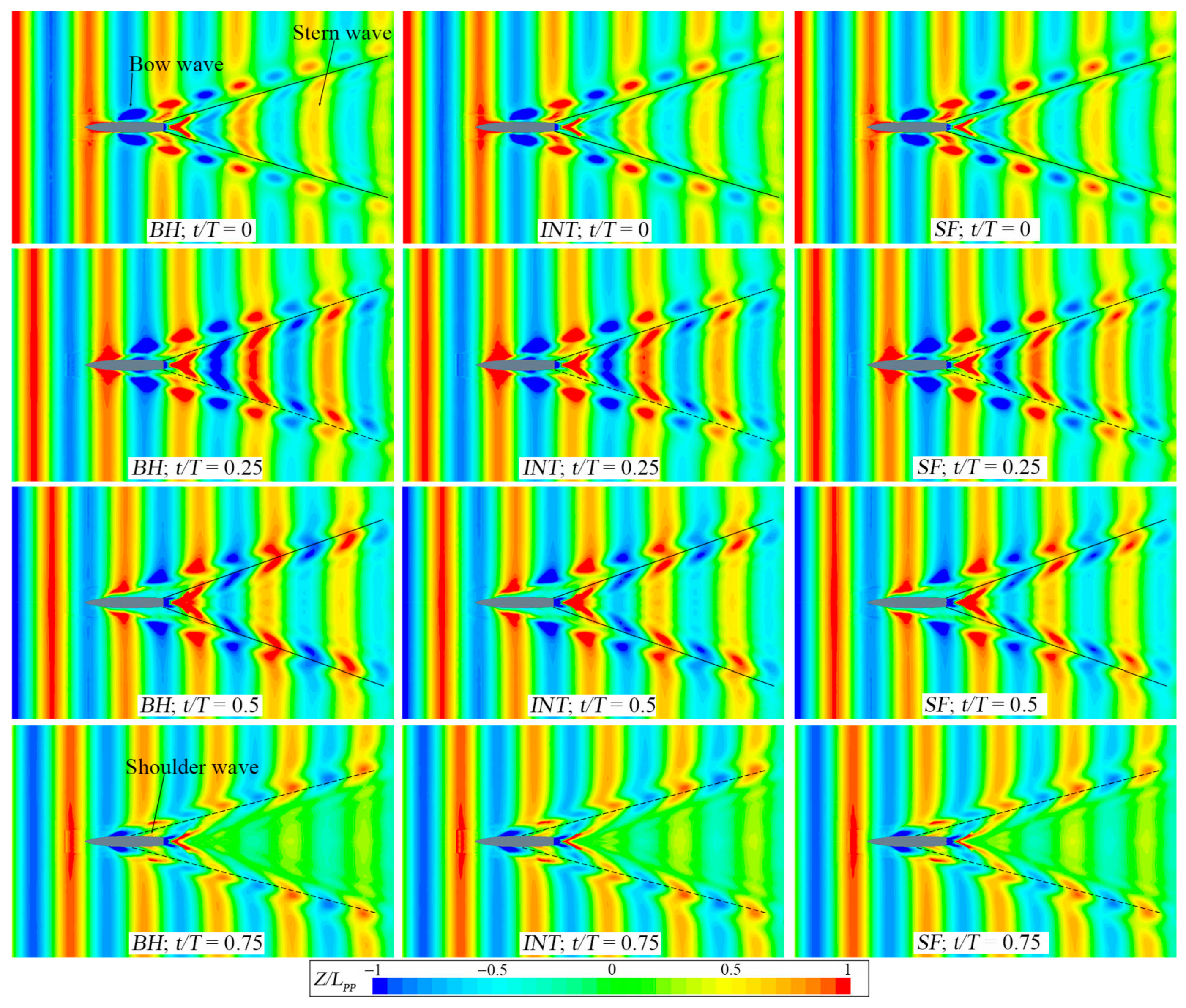





| Main Dimensions | Symbols | Model Scale | Full Scale |
|---|---|---|---|
| Length between perpendiculars | LPP (m) | 6.670 | 106.72 |
| Length at water level | LWL (m) | 6.670 | 106.72 |
| Molded breadth | B (m) | 0.758 | 12.13 |
| Draft | T (m) | 0.240 | 3.84 |
| Wetted surface | S (m2) | 5.453 | 1396 |
| Displacement | ∇ (m3) | 0.549 | 2249 |
| λ/LPP | ak | fe |
|---|---|---|
| 0.5 | 0.075 | 1.654 |
| 1 | 0.075 | 0.969 |
| 1.25 | 0.075 | 0.821 |
| 1.5 | 0.075 | 0.718 |
| 1.75 | 0.075 | 0.643 |
| 2 | 0.075 | 0.585 |
| 2.5 | 0.075 | 0.500 |
| 1.5 | 0.025 | 0.718 |
| 1.5 | 0.05 | 0.718 |
| 1.5 | 1 | 0.718 |
| 1.5 | 0.125 | 0.718 |
| 1.5 | 0.15 | 0.718 |
| Gf | Gm | Gc | Tf | Tm | Tc | |
|---|---|---|---|---|---|---|
| Ct0 | 0.007329 | 0.007341 | 0.007398 | 0.007329 | 0.007284 | 0.007137 |
| TF3 | 0.4364 | 0.4315 | 0.4235 | 0.4364 | 0.4263 | 0.4031 |
| TF5 | 0.2982 | 0.2971 | 0.2955 | 0.2982 | 0.2944 | 0.2869 |
| RG | PG | UG (Sf %) | RT | PT | UT (Sf %) | |
|---|---|---|---|---|---|---|
| Ct0 | 0.2046 | 2.2889 | 0.93 | 0.3050 | 1.7131 | 3.57 |
| TF3 | 0.6129 | 0.7063 | 3.30 | 0.4358 | 1.1984 | 2.56 |
| TF5 | 0.6890 | 0.5374 | 1.66 | 0.5144 | 0.9591 | 2.22 |
| Experimental Value | Simulation Value | Error (%) | |
|---|---|---|---|
| Ct−cw | 0.007060 | 0.006895 | −2.34 |
| Trim (°) | −0.337 | −0.342 | 1.48 |
| Sinkage (mm) | −11.0 | −10.6 | −3.64 |
| Experimental Value from [31] | Our Simulation Value | |
|---|---|---|
| INT | −6.92% | −5.65% |
| SF | −8.61% | −7.52% |
Disclaimer/Publisher’s Note: The statements, opinions and data contained in all publications are solely those of the individual author(s) and contributor(s) and not of MDPI and/or the editor(s). MDPI and/or the editor(s) disclaim responsibility for any injury to people or property resulting from any ideas, methods, instructions or products referred to in the content. |
© 2024 by the authors. Licensee MDPI, Basel, Switzerland. This article is an open access article distributed under the terms and conditions of the Creative Commons Attribution (CC BY) license (https://creativecommons.org/licenses/by/4.0/).
Share and Cite
Song, K.; Gong, J.; Ma, J.; Xu, Q.; Shi, Y.; Xu, F. Numerical Study on the Influence of Interceptor and Stern Flap on Ship Resistance and Motion Response in Regular Waves. J. Mar. Sci. Eng. 2024, 12, 929. https://doi.org/10.3390/jmse12060929
Song K, Gong J, Ma J, Xu Q, Shi Y, Xu F. Numerical Study on the Influence of Interceptor and Stern Flap on Ship Resistance and Motion Response in Regular Waves. Journal of Marine Science and Engineering. 2024; 12(6):929. https://doi.org/10.3390/jmse12060929
Chicago/Turabian StyleSong, Kewei, Jie Gong, Jincun Ma, Qiang Xu, Yue Shi, and Feng Xu. 2024. "Numerical Study on the Influence of Interceptor and Stern Flap on Ship Resistance and Motion Response in Regular Waves" Journal of Marine Science and Engineering 12, no. 6: 929. https://doi.org/10.3390/jmse12060929
APA StyleSong, K., Gong, J., Ma, J., Xu, Q., Shi, Y., & Xu, F. (2024). Numerical Study on the Influence of Interceptor and Stern Flap on Ship Resistance and Motion Response in Regular Waves. Journal of Marine Science and Engineering, 12(6), 929. https://doi.org/10.3390/jmse12060929






